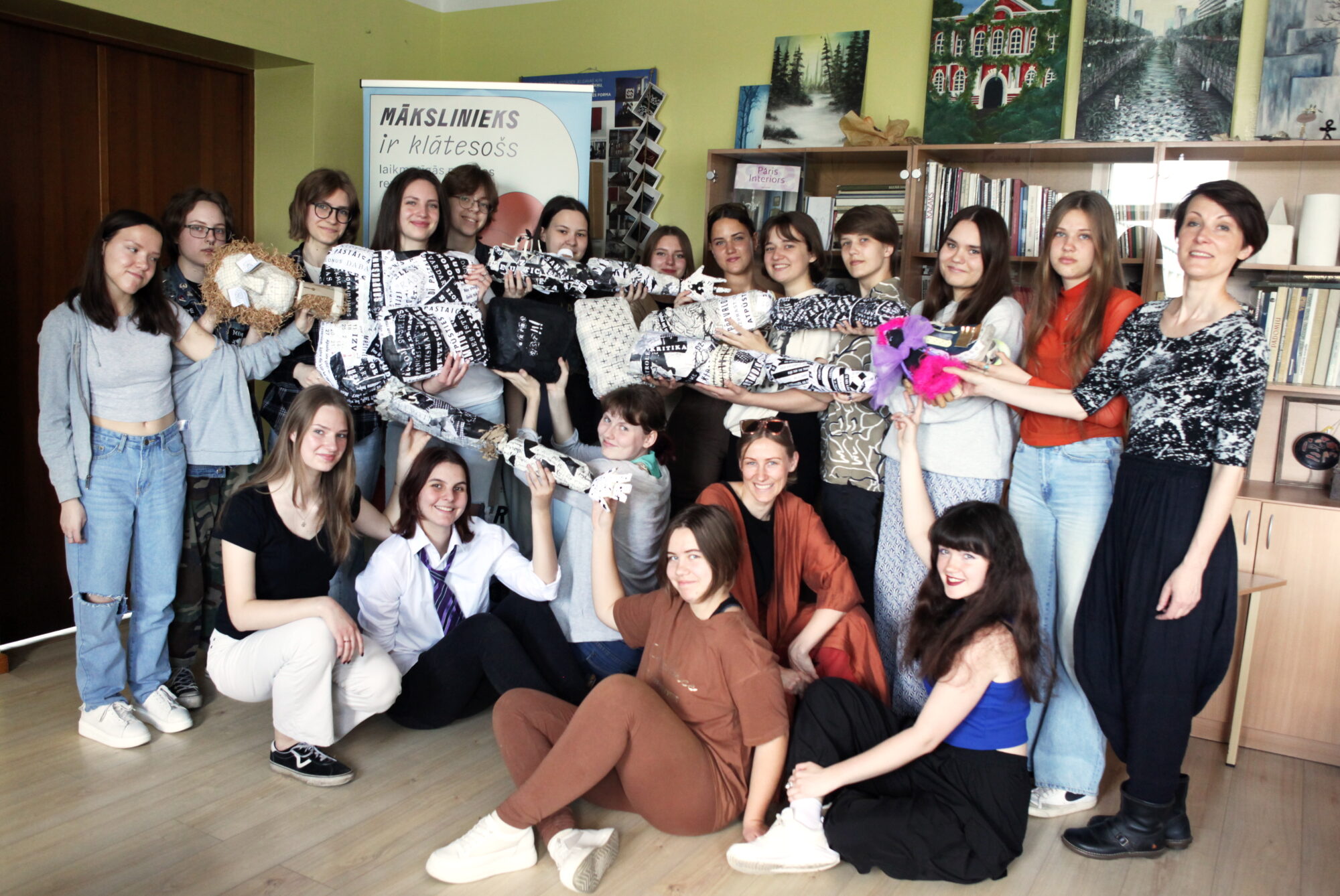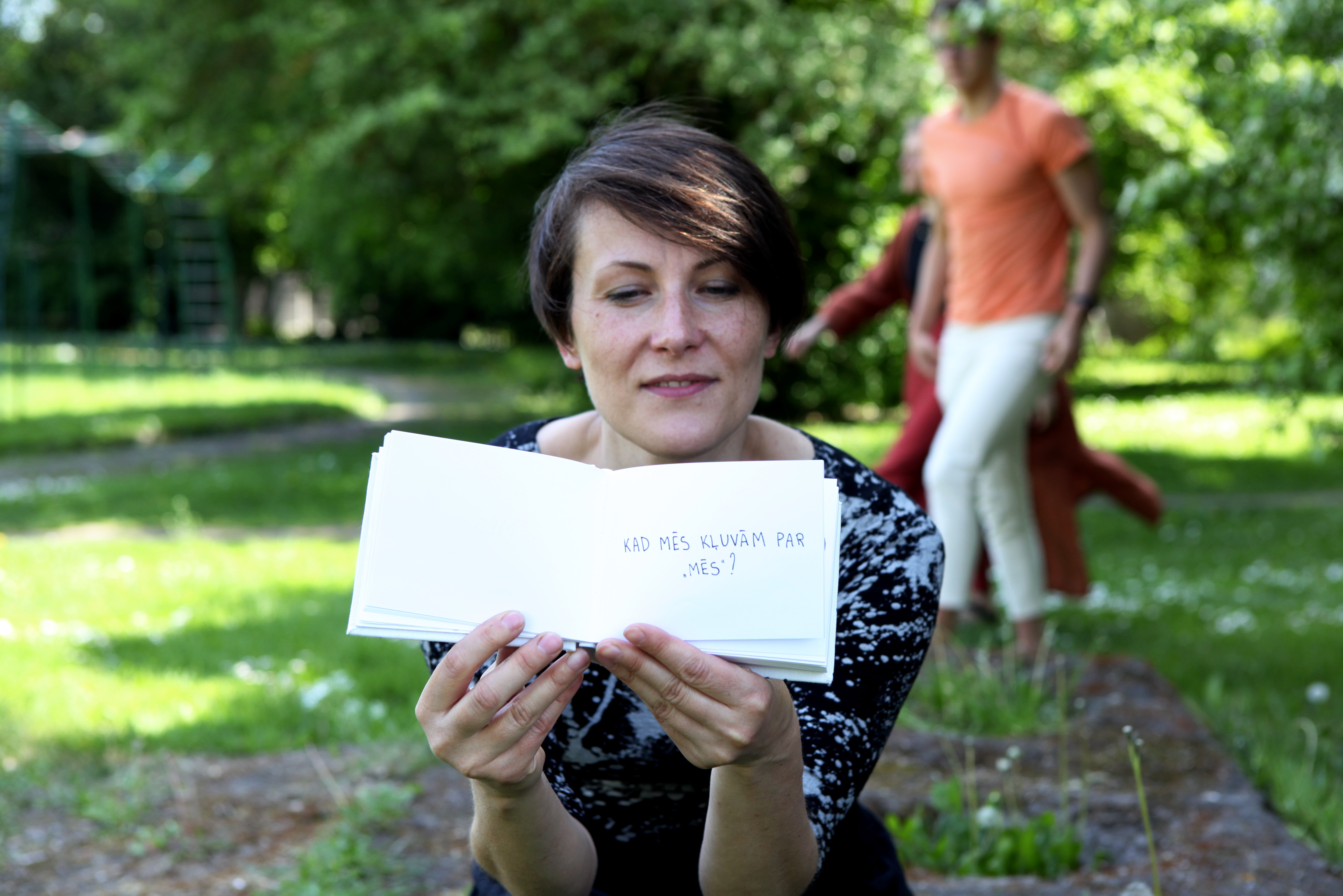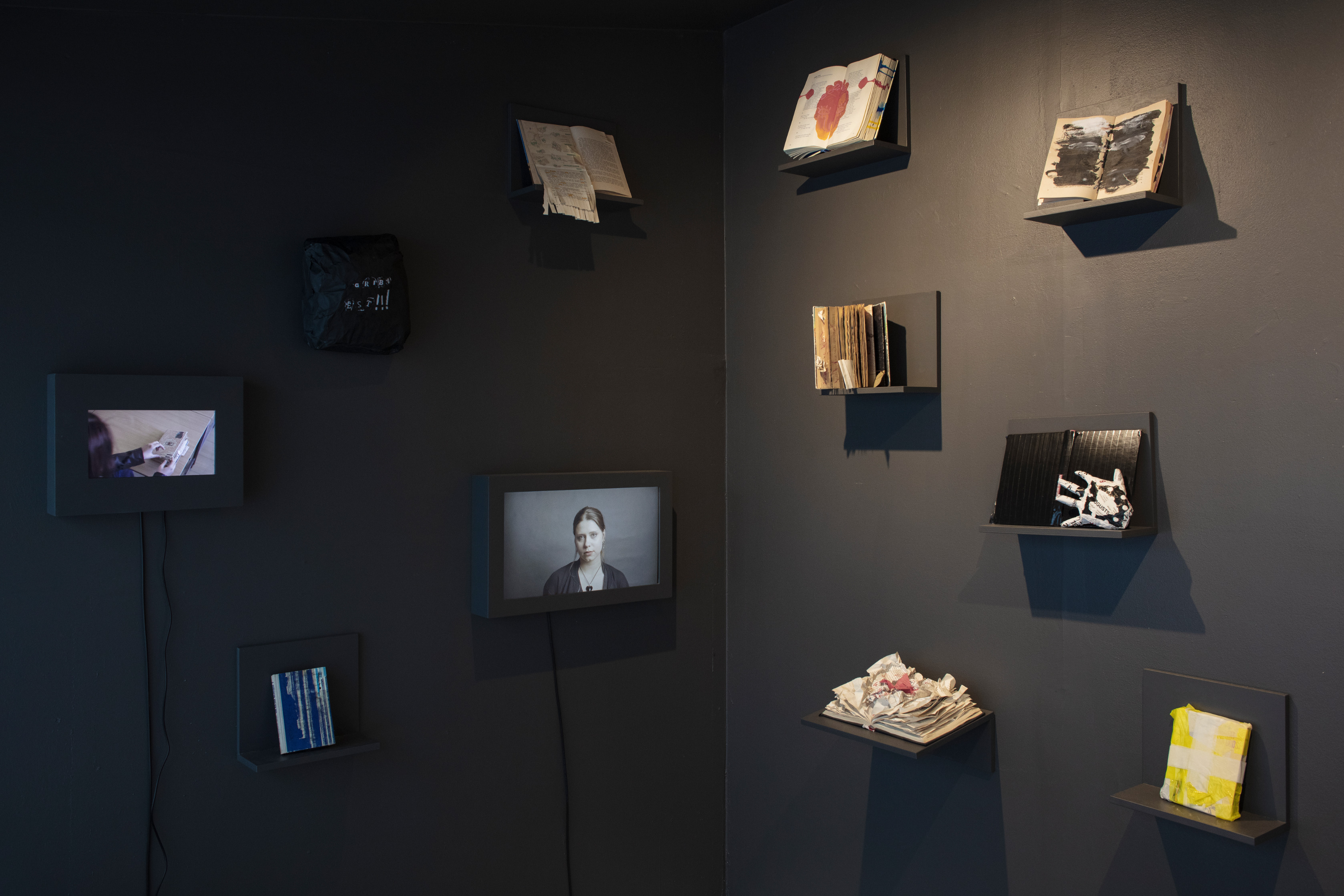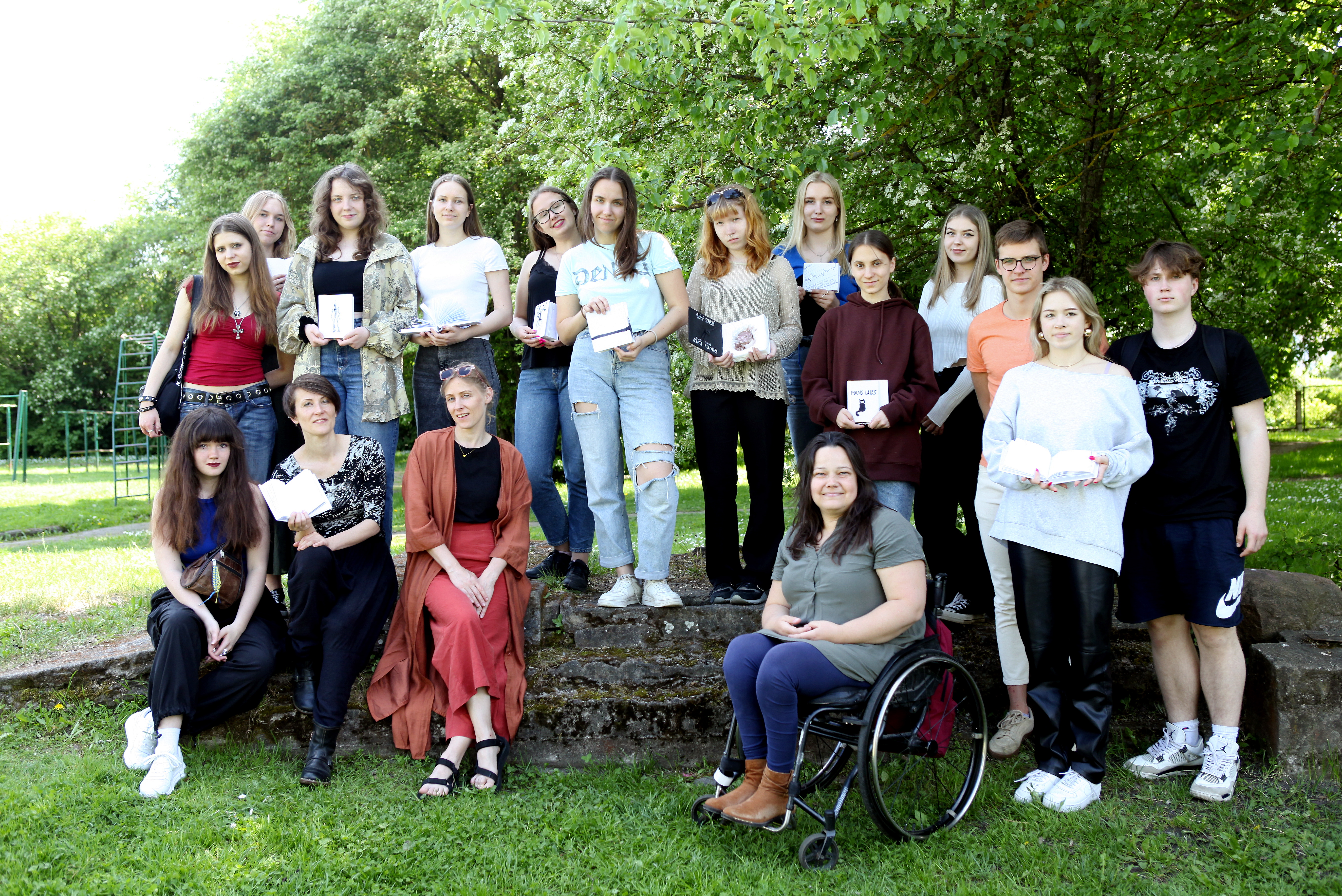May 31, 2024
“A place where to be, before heading further” – Eva Vēvere at Jelgava Spīdola State Gymnasium

As part of the project, seven Latvian artists visited six schools throughout Latvia where they took part in art residencies with students.
Read and get to know what Eva Vēvere did in Jelgava!
Who? The artist Eva Vēvere and 2 high school classes: Grade 10 and Grade 11 students
When? From February until May 2023, meeting the students every week
Where? At the Jelgava Spīdola State Gymnasium
Other people involved? Art pedagogue Indra Soika-Dreimane, the teacher Ieva Hofmane, and the art mediator Evelīna Andžāne
Watch here:The artist’s Eva Vēvere’s residency at Jelgava Spīdola State Gymnasium
Contemporary art is not only finished works of art submitted for evaluation, but also a set of tools. These are tools, algorithms, methods of thinking, with the help of which it is possible to analyze and revise already generally known assumptions. With this toolkit, you can approach contemporary art, building it up and then taking it apart piece by piece, asking precise questions, as well as explore its authors themselves, their creative motives. In this way, you can go back quite far, looking for connections and causes of what has manifested itself in a visible work of art. Therefore, the creative process can become an excellent test for discovering and exploring one’s own identity. Especially if you are a young person who soon will have to rapidly find your own place in the world of adults.

The artist Eva Vēvere works with the largest group of students in all “The Artist Is Present” residencies. She has decided to collaborate with both Grade 10 and Grade 11 at Jelgava Spīdola State Gymnasium at the same time. The art mediator Evelīna Andžāne also participates in some of the workshops. The students of this school are highly motivated, with excellent grades and academic achievements. At a time when they have to prepare for exams and choose their future career path, these young people must also reveal themselves as individuals who have to make decisions and take responsibility for what they have decided. Eva finds this age and its problems, as well as the contrast between the individual and the collective, compelling from the point of view of artistic and philosophical issues. Jelgava Spīdola State Gymnasium is an educational institution with long traditions, a special atmosphere and ambitions. How does it affect the student’s personality? How does a purposefully cultivated collective spirit coexist with the individuality of each youth? And how is it possible to talk about it in large working groups while addressing each one individually?
This “The Artist Is Present” residency becomes a research field for the questions raised by Eva, because the goal of the project is twofold – not only to give students an insight into the work of an artist, but also for the artist to get inspiration and a platform for creative work as an author. Connecting these two goals allows for creating a collaborative work of art which will later be exhibited at “The Artist Is Present” exhibition at the festival Survival Kit 14.
Eva Vēvere is a visual artist who participates in projects both in Latvia and in the broader Nordic region. In her works, she questions the true meaning of various signs and concepts, searching for deeper levels of perception, often rooted in intuition and the subconscious. She is interested in the study and deconstruction of externally hidden systems, and later the artist presents her discoveries in an elegant language of visual and multimedia symbols. Eva creates installations, drawings, works with sound and video in interactive, performative projects, in which the viewer often becomes an integral part of the artwork. She also collaborates with other authors – performers, contemporary music professionals and dancers, using them as media for the physical expression of her ideas.

Eva meets with the students twelve times to gradually, level by level, unlock the basic questions that make up contemporary art – what to make? How to show it? Who am I or my attitude in it? In parallel with this, these questions are also asked to each student during the lessons, assessing each individual’s personality and feelings. Each meeting is carefully planned and different – there are new tasks and topics that students must think about beforehand.
Eva creates the lesson content in coordination with the high school curriculum. The lessons take place during the regular school classes. In the first part of the residency, she and the students work with contemporary art learning tasks, while in the second part they focus on creating the content of the exhibition. The artist shows examples of her creative activity where it is needed. Sometimes, before starting work, students do warm-up activities. The collaboration with both classes takes place during the same visit, but with each class separately. Sometimes there are as many as thirty students in the room. Eva divides them into groups only for certain tasks, because it is every student’s individual work that is important. In these moments, the presence of an art mediator, who provides practical help, is useful. Also important are conversations with students after each joint master class – their feedback influences the course of the next meeting.
During her first meeting with the students, Eva devotes time to dynamic introductory conversations with the students and, combining them in groups, asks them to draw a large-format map of contemporary art. They must turn their assumptions and opinions about art into visual navigation symbols with the help of raising questions. In this way, the overall level of knowledge of young people is marked, besides, each one collects his own thoughts about the nature of art.

Next time, the students focus on questions of identity – each one of them receives a randomly selected book, which, regardless of its content, becomes a material unit for the physical expression of personality. With the help of simple tools – black paper, colour ink, glue, markers – the youths transform the books in a variety of ways – sometimes they keep their original function, but change their content, and other times they become objects and acquire a completely new meaning. After that, the students go to Riga – to the exhibition hit of that time titled “Sneakers: eco x ego” as Pauls Stradiņš Medicine History Museum. During this tour, they have to explore the wide range of multimedia and idea presentation types in the exhibition and to find answers to why they are used in the way they are.
Later, the students themselves take Eva on an excursion around Jelgava. In their itinerary, they must include, for example, places where ideas can be realized or a point where you feel the best, as opposed to “dead zones” where nothing happens. Here, in the real-life space, the students should also use what they marked on the map in the first lesson. In this way, Eva will repeatedly connect and show, in an unexpected way, the works created in the previous meetings with the students. In the following sessions, the students of Spīdola Gymnasium will draw objects which characterize them, as well as an abstract schematic of collective identity, will create micro-performances depicting their characteristic gestures, which will be recorded on video, and create audio motifs together. Later, all of this, combining the most successful creations, will be used in the work for “The Artist Is Present” exhibition. Through hands-on work, the students also become familiar with various art and multimedia technology practices, which are cleverly interwoven in the exercises they are carrying out. Working in this way, Eva and the youths gradually create their own, original, small works of art on the topic of identity. They intentionally avoid quoting and using any other sources outside the group (such as other artworks, pop culture), working only with their own internal world. Although all of these objects and video/audio clips were created by carrying out an exercise given to all of the students, at the same time and in the same space (during a lesson in the classroom), each one of them is capable of showing the individuality and originality of the particular author. The participants use semantically rich symbols – books, the body, gestures, time and calendar, texts as visual signs, which the youths utilize, with understanding and excitement, for the public presentation of their identity. That what would be strange to translate into words and may cause shyness when doing so can be very successfully revealed in the visual and aural code systems of contemporary art.
The difficulties faced by the artist and the students in “The Artist Is Present” residency are related to the heavy study load of the young people. There are situations when the exams in other subjects that take place after the lesson do not allow the students to fully focus on what is happening in the lesson. Also, they are often tired already when they arrive, and this prevents them from concentrating to follow the active rhythm of the workshops. Indra Soika-Dreimane, the art and culture pedagogue of Jelgava Spīdola State Gymnasium, who participates in organizing the residency, admits that it required thorough coordination and planning and that sometimes teachers of other subjects had to move their classes for a the residency to unfold more successfully. Also, the question of how to evaluate the results produced in this format with respect to the standards of the education system is still unclear.
In August, Eva meets with her students Elizabete, Dairita, Emīlija Elza, Ance and Daniela again in Valmiera, at the contemporary art summer camp run by the Latvian Centre for Contemporary Art. Here they are joined by the Norwegian artist Helen Eriksen. She is from the Oslo-based artist collective Tenthaus, which has been leading similar artist visits to Norwegian schools already for the past ten years. Over the course of several months, based on their experience, Tenthaus has provided advice to the participants of “The Artist is Present” project in online group meetings, as well as through individual consultations. Together, Eva and Helen develop several open workshops for the residents of Valmiera, as well as resourcefully involve the students of the Jelgava Spīdola State Gymnasium in doing so. The girls themselves develop and lead a book-making master class based on the creative practices they have studied in the spring.

In September, during the festival Survival Kit 14 and the exhibition “The Artist Is Present”, the artwork “A Place Where to Be” is unveiled in Vidzeme Market. It is a typical market stall, a very small space, but the diversity of the artworks and the message it contains expands the physical boundaries of the space much further. The exhibition’s constituent elements are created by many authors – young people who have created tangible, visible and audio notes whilst engaging in a self-exploration of their identity. The artist Eva Vēvere, who carefully led this process, by attentively delving into it, but at the same time maintaining a playful, youthful lightness, even rebelliousness, connected the many constituent elements into a well-considered and balanced whole. In the midst of the rough, layered materiality of the market, “A Place Where to Be” is a clean and conceptual space where you can get to know the many sharp facets of human identity that are just as clear and direct.
Authors of the artwork “A Place Where to Be” (paper objects, textile, sound installation, video, 2023): Eva Vēvere and Jelgava Spīdola State Gymnasium Grade 10 and Grade 11 students: Arīna Agejeva, Jevgeņija Aļeksova, Modris Arnītis, Annija Emīlija Bērziņa, Karīna Čerjapkina, Agnese Čuda, Gundega Gaujere, Līvija Līva Gernere, Nelda Katrīna Hofmane, Marta Daniēla Jēkabsone, Matīss Kaktiņš, Tīna Kamola, Laine Krilova, Elīna Ļubļinska, Maija Mašala, Alise Moroza, Kārlis Ošs, Laura Luīze Pētersone, Ksenija Popko, Kristīne Ragucka-Ragovska, Linda Katrīne Rēriha, Estere Skrabe, Ance Strauta, Līva Estere Strupule, Anna Sudakova, Adriāns Trahimovičs, Vanesa Vaškevica, Karina Volkova, Diāna Zagdaja, Māris Zemrūķis, Jana Adaškeviča, Ance Balode, Daniela Bebriša, Angelīna Cīrule, Vineta Dairita Danšina, Žanete Kalniņa, Emīlija Klīve, Dita Krūmiņa, Elizabete Liekmane, Marta Mišina, Anna Marija Ozola, Anastasija Pravotorova, Sofija Solodova, Estere Anna Sprūģe, Elizabete Enija Strode, Alise Šlosberga, Elza Šlosberga, Veronika Vazne, Emīlija Vuškārniece, Paula Zukule.
Eva’s insights:
- It seems to me that a big problem in the education system is that art and the study of art subjects loses its power and becomes something meaningless and boring if we only deal with aesthetic issues or skills. The task that I gave myself when creating this program was to show to the youths that art is as an electric charge which shines light on life, on events, the structure of the world, the systems we have created, and each one of us personally. To wake them up. Art as a tool for thinking. Art as a framing or point of view. Art as an activity. Art as a responsibility or freedom (but preferably both). These things are what really drive away the hated boredom.
- The residency format can make the work of teachers easier by offering an insight into the processes of contemporary art, performing an explanatory function, broadening understanding of currently relevant art media and their possibilities, and highlighting the frequently missing connection between historical art and contemporary art.
- Student involvement was good until May, when the exam time started, and when the deadlines for handing in other projects and various events began. In the last month of the semester, the students’ attendance, interest and energy level dropped significantly due to these reasons.
- As an artist, I can explore such a collaborative model and experience how others work with my ideas. Also – how ideas develop in interaction with students and how I “ping-pong” them back, in this way showing and experiencing together that everything is connected. I am also interested in what I can do with the students’ ideas. I noticed that some ideas that I find interesting are not at all interesting to the students and vice versa.
